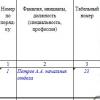Egyptian army BC. Army in ancient egypt. Weaponry innovations
The first weapon appeared at the dawn of civilization. The ancient hunter needed to defend himself from wild animals and get food for himself. After the emergence of states, wars began. The first large state was Ancient Egypt (from 3100 BC), whose history goes back about three thousand years. The Egyptians fought many enemies, created a well-organized army and learned how to make a variety of weapons.

The basis of the Egyptian army was the infantry. Large military units of 5 thousand people were divided into detachments of spearmen, archers, slingers, charioteers. Recruitment into the army was compulsory (10 out of 100 youths), in addition, volunteers were also accepted. Strict discipline reigned in the army. The Egyptians used different formations and walking in the leg.

The main throwing weapons of the infantry were bows and arrows. Even the pharaohs fired bows. The bows were simple, made of wood, and complex, reinforced with tendons, plates of bone and horn.

Darts and short spears were thrown by hand. In close combat, spears, axes, axes, daggers and crooked cleavers were used - khopeshi .

Khopesh - a curved curved cleaver for drawing
chopping and cutting blows. Bronze blade, handle
bronze, wood or bone
In ancient Egypt, all weapons were made only of bronze.

Ax - bronze warhead attached
to the wooden handle with plant fibers,
judging by the decorations it belonged to a noble military leader
The weapons of the pharaohs and large military leaders were decorated with gold, precious stones and colored pastes.

The main defensive weapons were rectangular wooden shields. They were covered with leather or skins. The body was protected by soft armor made of white fabrics. It was convenient in hot climates. The armor consisted of strips of linen wrapped around the body. They also used quilted linen cuirasses and leather combat belts. The head was covered with caps made of several layers of fabric. The rank and file fought naked to the waist, the lower body covered with a quilted cloth shield. A wig or a painted headdress was worn on the head. They fought barefoot, only rich people had leather sandals.

After numerous wars with tribes from Mesopotamia and Asia Minor, the Egyptians acquired lamellar armor made of bronze plates. Such armor could be ordered only by rich warriors - chariots.

War chariot - in it were the charioteer and the shooter.
Lamellar Archer - Owner of Chariot and Horses
As a kind of troops, chariots appeared after the conquest of Egypt by the Hyksos around 1700 BC. During the New Kingdom period after the expulsion of the Hyksos in the 1550s BC. the art of war in Egypt reached its zenith. Egyptian chariots were two-wheeled, lightweight, a wooden frame sheathed with leather, and a wicker floor.

The infantry began the battle by throwing arrows and javelins, then chariots with archers went into the attack, and then warriors with melee weapons entered the melee. The army of the Egyptians served as mercenaries and prisoners from Nubia, Syria, from the islands of the Mediterranean Sea.

Some of them came with their weapons, for example, the shardins from the island of Sardinia introduced the Egyptians to straight long swords and round shields. In the last centuries of the existence of the Egyptian kingdom, iron weapons appeared in it. In 30 BC. Ancient Egypt was conquered by the Romans and became a Roman province.
I found out that there is not a single one among them according to the history of the weapons of Ancient Egypt. But this is the cradle of European culture, which gave mankind a lot. As for the periodization of its history, it is traditionally divided into the Old Kingdom (XXXII century - XXIV century BC), Middle Kingdom (XXI century - XVIII century BC) and New Kingdom (XVII century - XI century BC) Before the Old Kingdom in Egypt there was a Predynastic period and then the Early Kingdom. After the New Kingdom, there was also the Late Period, and then the Hellenistic Period, and between the Ancient, Middle and New Kingdoms, as a rule, there were also transitional periods filled with turmoil and rebellions. Often at this time, Egypt was subjected to attacks by nomadic tribes and warlike neighbors, so that its history of peace was not at all peaceful, and military affairs in Egypt, which means that offensive and defensive weapons have always been held in high esteem!
Already in the era of the Old Kingdom - the era of the kings-builders of the pyramids in Egypt there was an army recruited from free peasants, individual units of which were armed with uniform weapons. That is, the army consisted of warriors with spears and shields, warriors with maces, small axes and daggers made of copper and bronze, and detachments of archers with large bows, whose arrows were tipped with flint. The task of the troops was to protect borders and trade routes from attacks by the Libyans - the most significant among the tribes of the "Nine Bows" - the traditional enemies of Ancient Egypt, the Nubians in the south and the Bedouin nomads in the East. During the reign of Pharaoh Sneferu, the king's army captured 70,000 prisoners, which indirectly speaks about the number of Egyptian troops, about the perfection of their tactics, and about their superiority in weapons!
Since it is very hot in Egypt, the ancient warriors did not have any special "military uniform" or protective clothing. All their clothes consisted of a traditional skirt, a lamb's wool wig, which played the role of a helmet, protecting the head from the stunning blow of the mace and shield. The latter was made of bovine hide with the wool outward, which, apparently, was combined in several layers and stretched over a wooden frame. The shields were large, covering the person up to the neck and pointed at the top, as well as somewhat smaller, rounded at the top, which the warriors held by the belts attached from the back.
The warriors formed a phalanx and moved towards the enemy, covering themselves with shields and putting out their spears, and the archers were behind the infantrymen and fired over their heads. Such tactics and approximately the same weapons among the peoples with whom the Egyptians fought at that time did not require any greater perfection of weapons - the more disciplined and trained warriors won, and it is clear that these were, of course, the Egyptians.
At the end of the Middle Kingdom, the Egyptian infantry, as before, was traditionally divided into archers, warriors with short-range percussion weapons (clubs, clubs, axes, axes, javelins, spears) who did not have shields, warriors with axes and shields, and spearmen. This "branch of the army" had shields 60-80 cm long and about 40-50 cm wide, as, for example, in the figurines of warriors found in the tomb of nomarch Mesekhti. That is, in the era of the Middle Kingdom, the Egyptians knew a deep formation of spearmen, covered with shields and built in several rows!
It is interesting that the troops of the Egyptians at this time consisted exclusively of infantry. The first case of the use of horses in Egypt was attested during the excavations of the city of Buchen - a fortress on the border with Nubia. The find belongs to the era of the Middle Kingdom, but although horses were already known at that time, they were not widespread in Egypt. It can be assumed that some wealthy Egyptian acquired it somewhere in the East and brought it to Nubia, but he hardly used it as a means of draft.
As for the infantry archers, they armed themselves with the simplest bows, that is, made from one piece of wood. A complex bow (that is, assembled from different types of wood and pasted over with leather) would be too difficult for them to manufacture, and expensive to supply ordinary infantrymen with such weapons. But one should not think that these bows were weak, because they had a length of 1.5 m and more, and in skillful hands they were a very powerful and long-range weapon. The English bows of the Middle Ages of yew or maple, and with a length of 1.5 to 2 m, were also simple, but pierced steel armor at a distance of 100 m, and the English archer despised anyone who could not fire 10 to 12 arrows in a minute. True, there is one subtlety here. They did not shoot directly at the men at arms, or they shot only at a very close distance: almost point-blank! At a long distance, volleys were shot upwards on command, so that the arrow fell on the knight from above and hit not so much himself as his horse. Hence the armor on the neck of the knight's horses from above! So there is no doubt about the capabilities of Egyptian archers armed with bows of this size, and they could well hit opponents not protected by metal armor at a distance of 75 - 100 m and up to 150 m under favorable conditions.
Ancient Egypt: weapons and armor of warriors on chariots
Over its thousand-year history, Egypt has experienced not only ups, but also downs. So the era of the Middle Kingdom ended with the invasion of the Hyksos nomads, its defeat and a period of decline. They were helped to cope with the Egyptians by the fact that they fought on two-wheeled high-speed chariots pulled by a pair of horses, which gave their troops unprecedented maneuverability and mobility. But soon the Egyptians themselves learned to breed and train horses, make chariots and fight on them. The Hyksos were expelled, Egypt experienced a new rise, and its pharaohs, no longer content with defending their borders and expeditions for gold to Nubia, began wars with their neighbors in Asia, and also tried to penetrate the territory of modern Syria and Lebanon.
Representatives of the Ramses dynasty were especially warlike pharaohs of the era of the onset of the New Kingdom. The armament of the soldiers at this time became even more lethal, since the metal processing technology was improved, and in addition to chariots, the Egyptians also learned a reinforced bow, which increased the range of the arrow and the accuracy of its hit. The power of such bows was truly great: it is known that such pharaohs as Thutmose III and Amenhotep II pierced copper targets with arrows fired from them.
Already at a distance of 50 - 100 m with an arrow with a metal leaf-shaped tip, apparently, it was possible to pierce the armor of a warrior on an enemy chariot. The bows were kept in special cases on the sides of the chariots - one on each (one spare) or one at the side closer to which the shooter was. However, using them has now become much more difficult, especially while standing on a chariot and, moreover, in motion.
That is why the military organization of the Egyptian army at this time also underwent major changes. In addition to the traditional infantry - "mesh", charioteers - "netheter" appeared. They now represented the elite of the army, all their lives they studied the military craft, which became hereditary for them and was passed on from father to son.
The very first wars in Asia brought rich booty to the Egyptians. So, after the capture of the city of Megiddo, they got: “340 prisoners, 2041 horses, 191 foals, 6 breeding horses, 2 war chariots decorated with gold, 922 ordinary war chariots, 1 bronze carapace, 200 leather carapaces, 502 battle bows, 7 hipped-roof pillars decorated with silver and belonging to the king of Kadesh, 1,929 head of cattle, 2,000 goats, 20,500 sheep and 207,300 sacks of flour. " The defeated recognized the power of the ruler of Egypt over themselves, took an oath of allegiance and pledged to pay tribute.
It is interesting that in the list of trophy shells there is only one bronze and 200 leather, which suggests that the presence of chariots also required increased protection of those who fought on them, since they were very valuable professional warriors, whom it was a pity to lose. But the fact that there is only one metal shell speaks of the extremely high cost of the then protective weapons, which only the princes and pharaohs of Egypt possessed.
The multitude of chariots taken as trophies unambiguously speaks of their wide distribution, not only among the Asians, but also among the Egyptians themselves. Egyptian chariots, judging by the images and artifacts that have come down to us, are light carts for two people, one of which drove horses, and the other fired at the enemy from a bow. The wheels had wooden rims and six spokes, the bottom was wicker, with the very minimum of wooden fences. This allowed them to develop high speed, and the supply of arrows in two quivers allowed them to wage a long battle.
The Battle of Kadesh - the largest battle between the armies of Egypt and the Hittite kingdom in 1274 BC. - Thousands of chariots participated on both sides, and although it actually ended in a draw, there is no doubt that it was the chariots that played a very important role in it. But in addition to new bows, the Egyptians also had two new types of long daggers - with a massive leaf-shaped blade with an edge in the middle, and a blade rounded at the end and piercing-chopping - with graceful, long blades with parallel blades that smoothly passed into a point, and also with a convex edge. The handle of both was very comfortable, with two cone-shaped sockets - upward with a pommel and downward with a crosshair.
The sickle-shaped (occasionally double-edged) bladed weapon, borrowed by the Egyptians from their enemies in Palestine and underwent a number of modifications in Egypt - "khopesh" ("khepesh"), was also widely used, like maces, axes with a narrow blade and moon-shaped axes.
This is how the infantry of Ancient Egypt, including the Ancient and Middle Kingdoms, could look like. In the foreground are two spear warriors in headscarves, with printed protective aprons in the shape of a heart over an ordinary apron, possibly in quilted jackets, with crescent short swords made of bronze, and then warriors with a battle club combined with an ax and a poleaxe with a moon-shaped blade. The dart thrower has no protective weapons at all. Two black warriors with bows in their hands - mercenaries from Nubia. Only one pharaoh has armor on his body, next to which there is a signalman with a drum. A box of a set of soldiers from the firm "Zvezda". Eh, what is not for the boys just now! And what soldiers I had in childhood - heaven and earth!

Narmer's palette. Depicts Pharaoh Narmer with a mace in his hands. (Cairo Museum)

Reconstruction of the chariot of the New Kingdom. (Römer-Pelizaeus Museum. Lower Saxony, Hildesheim, Germany)

Surprisingly, the ancient Egyptians knew and used boomerangs very similar to those used and used by the indigenous people of Australia. So these two boomerangs from the tomb of Pharaoh Tutankhamun are very similar to the Australian ones and differ from them only in their decoration! (Egyptian Museum, Cairo)

Pharaoh Tutankhamun on a chariot. Painting on wood, length 43 cm. (Egyptian Museum, Cairo)

Gold dagger of Pharaoh Tutankhamun. (Egyptian Museum, Cairo)

Pharaoh on a chariot. Wall painting in the Abu Simbel temple.

Relief from the funeral temple of Queen Hatshepsut depicting Egyptian soldiers of the 18th dynasty, 1475 BC. e. Limestone, painting. (Egyptian Museum Berlin)
Looking through the archive of my publications on the history of armor and weapons, published in VO, I discovered that among them there is not a single one on the history of weapons of Ancient Egypt. But this is the cradle of European culture, which gave mankind a lot. As for the periodization of its history, it is traditionally divided into the Old Kingdom (XXXII century - XXIV century BC), Middle Kingdom (XXI century - XVIII century BC) and New Kingdom (XVII century - XI century BC) Before the Old Kingdom in Egypt there was a Predynastic period and then the Early Kingdom. After the New Kingdom, there was also the Late Period, and then the Hellenistic Period, and between the Ancient, Middle and New Kingdoms, as a rule, there were also transitional periods filled with turmoil and rebellions. Often at this time, Egypt was subjected to attacks by nomadic tribes and warlike neighbors, so that its history of peace was not at all peaceful, and military affairs in Egypt, which means that offensive and defensive weapons have always been held in high esteem!
Already in the era of the Old Kingdom - the era of the kings-builders of the pyramids in Egypt there was an army recruited from free peasants, individual units of which were armed with uniform weapons. That is, the army consisted of warriors with spears and shields, warriors with maces, small axes and daggers made of copper and bronze, and detachments of archers with large bows, whose arrows were tipped with flint. The task of the troops was to protect borders and trade routes from attacks by the Libyans - the most significant among the tribes of the "Nine Bows" - the traditional enemies of Ancient Egypt, the Nubians in the south and the Bedouin nomads in the East. During the reign of Pharaoh Sneferu, the king's army captured 70,000 prisoners, which indirectly speaks about the number of Egyptian troops, about the perfection of their tactics, and about their superiority in weapons!
Since it is very hot in Egypt, the ancient warriors did not have any special "military uniform" or protective clothing. All their clothes consisted of a traditional skirt, a lamb's wool wig, which played the role of a helmet, protecting the head from the stunning blow of the mace and shield. The latter was made of bovine hide with the wool outward, which, apparently, was combined in several layers and stretched over a wooden frame. The shields were large, covering the person up to the neck and pointed at the top, as well as somewhat smaller, rounded at the top, which the warriors held by the belts attached from the back.
The warriors formed a phalanx and moved towards the enemy, covering themselves with shields and putting out their spears, and the archers were behind the infantrymen and fired over their heads. Such tactics and approximately the same weapons among the peoples with whom the Egyptians fought at that time did not require any greater perfection of weapons - the more disciplined and trained warriors won, and it is clear that these were, of course, the Egyptians.
At the end of the Middle Kingdom, the Egyptian infantry, as before, was traditionally divided into archers, warriors with short-range percussion weapons (clubs, clubs, axes, axes, javelins, spears) who did not have shields, warriors with axes and shields, and spearmen. This "branch of the army" had shields 60-80 cm long and about 40-50 cm wide, as, for example, in the figurines of warriors found in the tomb of nomarch Mesekhti. That is, in the era of the Middle Kingdom, the Egyptians knew a deep formation of spearmen, covered with shields and built in several rows!
It is interesting that the troops of the Egyptians at this time consisted exclusively of infantry. The first case of the use of horses in Egypt was attested during the excavations of the city of Buchen - a fortress on the border with Nubia. The find belongs to the era of the Middle Kingdom, but although horses were already known at that time, they were not widespread in Egypt. It can be assumed that some wealthy Egyptian acquired it somewhere in the East and brought it to Nubia, but he hardly used it as a means of draft.
As for the infantry archers, they armed themselves with the simplest bows, that is, made from one piece of wood. A complex bow (that is, assembled from different types of wood and pasted over with leather) would be too difficult for them to manufacture, and expensive to supply ordinary infantrymen with such weapons. But one should not think that these bows were weak, because they had a length of 1.5 m and more, and in skillful hands they were a very powerful and long-range weapon. The English bows of the Middle Ages of yew or maple, and with a length of 1.5 to 2 m, were also simple, but pierced steel armor at a distance of 100 m, and the English archer despised anyone who could not fire 10 to 12 arrows in a minute. True, there is one subtlety here. They did not shoot directly at the men at arms, or they shot only at a very close distance: almost point-blank! At a long distance, volleys were shot upwards on command, so that the arrow fell on the knight from above and hit not so much himself as his horse. Hence the armor on the neck of the knight's horses from above! So there is no doubt about the capabilities of Egyptian archers armed with bows of this size, and they could well hit opponents not protected by metal armor at a distance of 75 - 100 m and up to 150 m under favorable conditions.
Ancient Egypt: weapons and armor of warriors on chariots
Over its thousand-year history, Egypt has experienced not only ups, but also downs. So the era of the Middle Kingdom ended with the invasion of the Hyksos nomads, its defeat and a period of decline. They were helped to cope with the Egyptians by the fact that they fought on two-wheeled high-speed chariots pulled by a pair of horses, which gave their troops unprecedented maneuverability and mobility. But soon the Egyptians themselves learned to breed and train horses, make chariots and fight on them. The Hyksos were expelled, Egypt experienced a new rise, and its pharaohs, no longer content with defending their borders and expeditions for gold to Nubia, began wars with their neighbors in Asia, and also tried to penetrate the territory of modern Syria and Lebanon.
Representatives of the Ramses dynasty were especially warlike pharaohs of the era of the onset of the New Kingdom. The armament of the soldiers at this time became even more lethal, since the metal processing technology was improved, and in addition to chariots, the Egyptians also learned a reinforced bow, which increased the range of the arrow and the accuracy of its hit. The power of such bows was truly great: it is known that such pharaohs as Thutmose III and Amenhotep II pierced copper targets with arrows fired from them.
Already at a distance of 50 - 100 m with an arrow with a metal leaf-shaped tip, apparently, it was possible to pierce the armor of a warrior on an enemy chariot. The bows were kept in special cases on the sides of the chariots - one on each (one spare) or one at the side closer to which the shooter was. However, using them has now become much more difficult, especially while standing on a chariot and, moreover, in motion.
That is why the military organization of the Egyptian army at this time also underwent major changes. In addition to the traditional infantry - "mesh", charioteers - "netheter" appeared. They now represented the elite of the army, all their lives they studied the military craft, which became hereditary for them and was passed on from father to son.
The very first wars in Asia brought rich booty to the Egyptians. So, after the capture of the city of Megiddo, they got: “340 prisoners, 2041 horses, 191 foals, 6 breeding horses, 2 war chariots decorated with gold, 922 ordinary war chariots, 1 bronze carapace, 200 leather carapaces, 502 battle bows, 7 hipped-roof pillars decorated with silver and belonging to the king of Kadesh, 1,929 head of cattle, 2,000 goats, 20,500 sheep and 207,300 sacks of flour. " The defeated recognized the power of the ruler of Egypt over themselves, took an oath of allegiance and pledged to pay tribute.
It is interesting that in the list of trophy shells there is only one bronze and 200 leather, which suggests that the presence of chariots also required increased protection of those who fought on them, since they were very valuable professional warriors, whom it was a pity to lose. But the fact that there is only one metal shell speaks of the extremely high cost of the then protective weapons, which only the princes and pharaohs of Egypt possessed.
The multitude of chariots taken as trophies unambiguously speaks of their wide distribution, not only among the Asians, but also among the Egyptians themselves. Egyptian chariots, judging by the images and artifacts that have come down to us, are light carts for two people, one of which drove horses, and the other fired at the enemy from a bow. The wheels had wooden rims and six spokes, the bottom was wicker, with the very minimum of wooden fences. This allowed them to develop high speed, and the supply of arrows in two quivers allowed them to wage a long battle.
The Battle of Kadesh - the largest battle between the armies of Egypt and the Hittite kingdom in 1274 BC. - Thousands of chariots participated on both sides, and although it actually ended in a draw, there is no doubt that it was the chariots that played a very important role in it. But in addition to new bows, the Egyptians also had two new types of long daggers - with a massive leaf-shaped blade with an edge in the middle, and a blade rounded at the end and piercing-chopping - with graceful, long blades with parallel blades that smoothly passed into a point, and also with a convex edge. The handle of both was very comfortable, with two cone-shaped sockets - upward with a pommel and downward with a crosshair.
The sickle-shaped (occasionally double-edged) bladed weapon, borrowed by the Egyptians from their enemies in Palestine and underwent a number of modifications in Egypt - "khopesh" ("khepesh"), was also widely used, like maces, axes with a narrow blade and moon-shaped axes.
This is how the infantry of Ancient Egypt, including the Ancient and Middle Kingdoms, could look like. In the foreground are two spear warriors in headscarves, with printed protective aprons in the shape of a heart over an ordinary apron, possibly in quilted jackets, with crescent short swords made of bronze, and then warriors with a battle club combined with an ax and a poleaxe with a moon-shaped blade. The dart thrower has no protective weapons at all. Two black warriors with bows in their hands - mercenaries from Nubia. Only one pharaoh has armor on his body, next to which there is a signalman with a drum. A box of a set of soldiers from the firm "Zvezda". Eh, what is not for the boys just now! And what soldiers I had in childhood - heaven and earth!
Narmer's palette. Depicts Pharaoh Narmer with a mace in his hands. (Cairo Museum)
Head of the mace of Pharaoh Nermer. (British Museum, London)
Darts and shield. Ancient Egypt. Middle Kingdom. Modern renovation. (Metropolitan Museum of Art, New York)
Painted figurines of warriors from the tomb of nomarch Mesekhti. (Cairo Museum)
Head of the mace of an Egyptian warrior. (Metropolitan Museum of Art, New York)
The ax of their tomb of Ahhotep. New kingdom. 18th dynasty, 16th century BC. (Egyptian Museum, Cairo)
Ancient Egyptian battle ax. (Metropolitan Museum of Art, New York)
Reconstruction of the chariot of the New Kingdom. (Römer-Pelizaeus Museum. Lower Saxony, Hildesheim, Germany)
VOISKO was organized in the form of military settlements located in the center of the country and in the most threatened areas; the main forces were in Lower Egypt, which was often attacked: there were fewer settlements in Upper Egypt, since the neighboring Nubian tribes could not be a serious enemy of the Egyptians due to their fragmentation. Moreover, the conquered Nubian tribes were obliged to give Egypt a certain number of soldiers to carry out the internal "police" service. During large campaigns, the pharaohs strengthened their army at the expense of the conquered neighboring tribes. These warriors cannot be considered mercenaries, since there is no evidence that they received any payment for participating in the campaign. One can only assume that they are entitled to a certain share in the spoils of war.
In the documents of the times of the Old Kingdom, the "house of arms" is mentioned - a kind of military department, which was in charge of the manufacture of weapons, the construction of ships, the supply of troops and the construction of defensive structures. There is no data on the number of Egyptian troops of the Old Kingdom period. With regard to the fleet, there is only one mention of a detachment of 40 ships sent for the cedars.
The warriors of the Old Kingdom were armed with: a mace with a stone tip, a battle ax made of copper, a spear with a stone tip, a battle dagger made of stone or copper. In the earlier period, the boomerang was widely used. The main weapon was a bow and a battle ax. As a protective weapon, the warriors had a wooden shield covered with fur.
The army consisted of detachments. Sources that have come down to us say that the soldiers were engaged in combat training, which was in charge of a special chief of military training. Already in the period of the Old Kingdom, the Egyptians used the formation of ranks. All the soldiers in the ranks had the same weapon.
| Egyptian fortress in Semne. Reconstruction |
The fortresses of the Old Kingdom period were of various shapes(circle, oval or rectangle). The fortress walls sometimes had round towers in the form of a truncated cone with a platform at the top and a parapet. Thus, the fortress near Abydos was built in the shape of a rectangle; the length of its sides reached 125 and 68 m, the height of the walls - 7-11 m, the thickness in the upper part - 2 m. The fortress had one main and two additional entrances. The fortresses in Semne and Kumme were already complex defensive structures with ledges, walls and a tower.
|
Image on the walls of Inti's tomb in Deshasha |
During the assault on the fortresses, the Egyptians used assault ladders with wooden disc wheels, which facilitated their installation and movement along the fortress wall. A breach in the fortress walls was made with large crowbars. This is how the technique and methods of storming fortresses were born. The Egyptians were not born sailors, and for a long time their voyages were limited to the Nile and the adjacent canals, which represented the most convenient communication routes among the mountains and deserts surrounding the country. The absence of forests, with the exception of acacia, a hard and not very suitable for shipbuilding tree, forced for a long time to build (or, as they called, "knit") ships from long bundles of papyrus, a reed that grows in abundance in the country. Over time, the Egyptians had to use acacia in shipbuilding.
The ships of the Egyptians were rowing, but they had sails. Each ship had a permanent crew headed by a chief. The squadron of ships was led by the chief of the fleet. The construction of ships was in charge of the so-called ship builder. Was created "two large fleets": one - in the Upper, the other - in Lower Egypt.
Naval ships raided the Mediterranean.
Organization of the Egyptian army in the era of the Middle Kingdom
The TERRITORY of Egypt during the Middle Kingdom was approximately 35 thousand square meters. km. Its population, according to ancient authors and modern estimates, was approximately 7 million people. Judging by the available data on recruitment in one of the nomes (one soldier out of a hundred men), the Egyptian army could have consisted of several tens of thousands of soldiers. Several thousand soldiers usually took part in the campaign. Pharaoh had with him the "people of the retinue" who made up his personal guard, and the "companions of the ruler" - a group of noble warriors loyal to him, from which military leaders were appointed: "the chief of the army", "the chief of recruits", "the military commander of Central Egypt" and others commanding persons.
Armament Egyptian warriors The period of the Middle Kingdom has slightly improved compared to the previous period, since the processing of metal has become more perfect. Spears and arrows now had bronze tips. The strike weapon remained the same: a battle ax, a spear up to 2 m long, a mace and a dagger.
As a throwing weapon, a spear for throwing, a boomerang, a sling for throwing stones, and a bow were used. A reinforced bow appeared, which increased the range of the arrow and the accuracy of its hit.
The arrows had tips of various shapes and plumage; their length ranged from 55 to 100 cm. Arrows with a leaf-shaped tip, originally flint, and then copper and bronze, common for the ancient East, were less effective weapons than arrows with a faceted tip - bone or bronze, introduced by the Scythians in the second quarter of the 1st millennium. The fur-lined shield, half a man's height, continued to be the only protective piece of equipment.
During the Middle Kingdom, the organization of the army was improved. The divisions now had a certain number of 6, 40, 60, 100, 400, 600 soldiers. The detachments numbered 2, 3, 10 thousand soldiers. Units of uniformly armed warriors appeared - spearmen and archers, who had a formation order for movement; moved in a column in four rows along the front and ten rows deep.
For their merits, the soldiers were promoted, received land, livestock, slaves, or were awarded "gold praise" (like an order) and decorated military weapons.
From the west and east, access to Egypt was reliably protected by the Libyan and Arabian deserts.
To protect the southern border, three lines of fortresses were built in the area of the first and second rapids of the Nile. The fortresses became more perfect: they now had battlements that covered the defending warriors; protruding towers for shelling the approaches to the wall; a moat that made it difficult to approach the wall. The fortress gates were protected by towers. Small exits were arranged for sorties. Much attention was paid to supplying the garrison of the fortress with water, wells or hidden exits to the river were arranged.
Of the surviving remains of ancient Egyptian fortresses of that period, the most characteristic is the fortress in Mirgis, built in the shape of a rectangle.
This fortress has an internal wall 10 m high with protruding towers located at a distance of 30 m from one another on the opposite face from the river, and a moat 8 m wide. 25 m from inner wall an outer wall was built, which covers the fortress from three sides; on the fourth side, a rock drops abruptly to the river. The outer wall is surrounded by a moat 36 m wide. In addition, forward-facing walls were built on the rocky ledges, adjoining the corners of the fortress and allowing to flank the approaches from the river. Other walls protected the main entrance to the fortress. The fortress in Mirgis was already a complex defensive structure, which was based on the requirement of flanking the approaches. This was a step forward in the development of fortification, one of the branches of the art of war.
The most vulnerable spot in the country's defense was the north - the lower reaches at the confluence of the Nile into the Mediterranean Sea were open to conquerors. When the Pharaonic rule in the country was strong, it was here that the Egyptians kept the bulk of their fleet and land army. But during the uprisings against the royal power, the defense of the northern borders was sharply weakened, and the Asians-nomads could freely penetrate into Egypt.
The pharaohs and their commanders tried to fight quickly in order to return the troops home in a few months. Often the Egyptian army returned home after a three- or four-month campaign, capturing only one or two small fortresses. Major battles were rare - the generals took care of the soldiers, whom they called "the flock of God."
Organization of the Egyptian army in the era of the New Kingdom
The EGYPTIAN army during the New Kingdom was a military caste, which was divided by age or length of service into two groups, distinguished by the clothes they wore. The first group, according to Herodotus, numbered up to 160 thousand people, the second - up to 250 thousand. Presumably, these figures give the size of the entire military caste, including the elderly and children, and possibly women. So, at best, only tens of thousands of soldiers could go on a campaign.
Most of the warriors of the New Kingdom were armed with swords, and the bow played a significant role in the battle. The defensive armament was improved: the warrior, in addition to the shield, also had a helmet and a leather carapace with attached bronze plates. War chariots were an important part of the army. The chariot was a wooden platform (1x0.5 m) on two wheels, to which the drawbar was tightly attached. The front part and sides of the chariot were sheathed with leather, which protected the legs of the combat crew, which consisted of a driver and one fighter, from arrows. Two horses were harnessed to the chariot.
The main force of the Egyptian army was the infantry, which, after the introduction of uniform weapons, consisted of archers, slingers, spearmen, warriors with swords. The presence of equally armed infantry raised the question of the order of its formation.
If at an earlier time the Egyptians fought in deep, closed formations in the form of columns, then later, as a result of the improvement of weapons and the acquisition of combat experience, the depth of the formation decreases, and the front lengthens - this was caused by the need to use more soldiers and weapons while acting simultaneously. The battle formation of the heavy infantry of the Egyptians consisted of one closed line of 10 or more ranks in depth. War chariots were the mobile force of the Egyptian battle formation. A tightly closed formation of 10 or more ranks in depth (phalanx) was introduced for the first time not in Ancient Greece, and in the countries of the Ancient East.
The tactics of the Egyptians came down mainly to a frontal attack.
The battle before the appearance of war chariots began on foot soldiers - archers and javelin throwers, then the opponents approached and decided its outcome with hand-to-hand combat. With the advent of chariots, the battle became more complicated - chariots, for example, at Ramses II, were built in one open line and were located in front, on the flanks and behind the infantry. The chariot attack was aimed at disrupting the enemy ranks with the first blow. The success of the battle depended on a combination of war chariots and infantry.
War chariots, moreover, were a powerful means of pursuing the enemy. During the campaign, the Egyptian army was divided into several detachments, which moved in columns. Intelligence was sent ahead. At stops, the Egyptians set up a fortified camp of shields. When storming cities, they used a structure called a "turtle" (a canopy of shields that covered the soldiers from above), a ram, a vinea (a low canopy of grape vines covered with turf to protect soldiers during siege work) and an assault ladder.
A special body was in charge of supplying the troops. Products were dispensed from warehouses according to certain rates. There were special workshops for the manufacture and repair of weapons.
During the New Kingdom period, the Egyptians had a strong navy. The ships were equipped with sails and a lot of oars.
According to some reports, the bow of the ship was adapted for ramming an enemy ship.
Since the period of the Old Kingdom, Egypt has fought a huge number of wars of an aggressive and defensive nature. For these purposes, a strong united army of well-trained warriors was required.
Ancient Egyptian army structure
In the Old Kingdom there were no regular troops yet, they consisted of mercenaries. Such hired soldiers were recruited only during military campaigns, and in peacetime they went about their usual activities. They were paid well.
Already in the era of the Middle Kingdom, the army was quite highly organized. The Egyptian troops were structured, recruiting into the army took place on a voluntary basis. There was a high military position - the jati, who commanded the army and navy and oversaw the recruitment of soldiers. At the same time, special detachments of career officers appeared, they carried out special military orders of the pharaohs. At the same time, a guard was formed to protect the king.
According to ancient Egyptian law, a person with wealth, in order to become an aristocrat, had to take 8 soldiers into his service. They had to be constantly trained and engaged in military training, without burdening them with ordinary work. Noble rich men formed divisions-companies, which were subordinate to the colonels. In the era of the New Kingdom, there were many foreign mercenaries in the army, and later they formed the basis of the Egyptian army.
Armament of the army of ancient Egypt
The main force of the Egyptian army was infantry troops and chariot detachments, and from the period of the Middle Kingdom, a combat fleet began to appear. Most often, warriors were armed with a copper ax, mace, bow, spear or copper dagger. For protection, they used a shield made of wood, which was covered with fur. In the Middle Kingdom, in connection with the development of metalworking, the spear, sword and arrowhead became bronze. At this time, detachments of archers and spearmen appear.




















